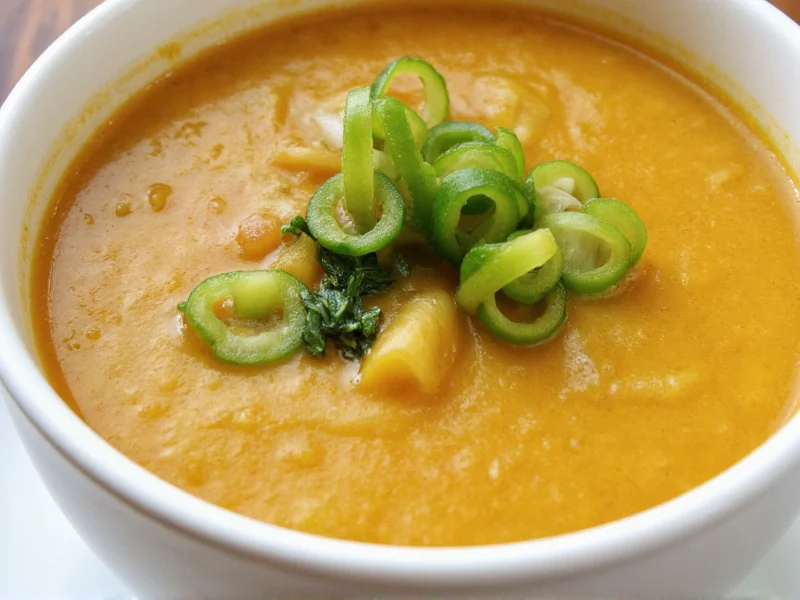Zucchini soup transforms a humble summer squash into a sophisticated, nutrient-dense meal that works equally well as a light lunch or elegant starter. This versatile dish shines during zucchini's peak season but can be enjoyed year-round with proper technique. Unlike many vegetable soups that become watery or bland, expertly crafted zucchini soup maintains vibrant color and concentrated flavor through strategic ingredient preparation and cooking methods.
The Essential Zucchini Soup Recipe
Creating exceptional zucchini soup requires attention to ingredient ratios and cooking sequence. The following recipe yields four servings of velvety, restaurant-quality soup without heavy cream or excessive fats.
| Ingredient | Quantity | Preparation Notes |
|---|---|---|
| Fresh zucchini | 2 pounds (900g) | Medium dice, skin on for nutrients and color |
| Yellow onion | 1 medium | Finely chopped |
| Garlic cloves | 3 | Minced |
| Vegetable broth | 4 cups | Low-sodium preferred |
| Fresh basil | 1/4 cup chopped | Plus extra for garnish |
| Lemon juice | 2 tablespoons | Freshly squeezed |
| Olive oil | 2 tablespoons | Extra virgin |
Step-by-Step Preparation Guide
- Sweat the aromatics: Heat olive oil over medium-low heat. Add onions and cook until translucent (5-7 minutes) without browning. Add garlic and cook 1 minute until fragrant.
- Add zucchini strategically: Reserve 1/4 of diced zucchini for later. Add remaining zucchini to pot and cook 5 minutes, stirring occasionally.
- Build flavor foundation: Pour in vegetable broth, bring to gentle simmer, and cook uncovered for 15 minutes until zucchini is fork-tender.
- Create texture contrast: Remove pot from heat. Blend soup until smooth using immersion blender. Stir in reserved raw zucchini for texture variation.
- Finish with brightness: Add lemon juice and fresh basil. Season with salt and white pepper to taste. The acid balances the soup's natural sweetness.
Professional Technique: Avoiding Common Mistakes
Many home cooks struggle with watery or bland zucchini soup. The secret lies in moisture management. Zucchini contains 95% water, so proper technique prevents dilution. Never add raw zucchini directly to boiling broth—this releases too much water too quickly. Instead, sauté zucchini first to evaporate some moisture, or reserve a portion raw to add after blending for texture without excess liquid.
For dairy-free creaminess, consider these professional alternatives:
- Blend with 1/4 avocado for richness without altering flavor
- Add 2 tablespoons raw cashews during blending for subtle nuttiness
- Include 1/2 cup cooked white beans for protein boost and velvety texture
Seasonal Variations for Every Palate
Zucchini soup adapts beautifully to different flavor profiles and dietary needs. These variations maintain the soup's integrity while offering new experiences:
- Chilled summer soup: Omit cooking, blend raw zucchini with cucumber, Greek yogurt, and fresh dill for a refreshing gazpacho-style dish
- Spicy harissa version: Stir in 1-2 teaspoons harissa paste before serving for North African flair
- Protein-packed option: Add 1 cup shredded cooked chicken or white beans during final heating
- Low-carb adaptation: Replace half the zucchini with cauliflower for reduced carbohydrates
Storage and Serving Recommendations
Proper storage maintains zucchini soup's vibrant green color and fresh flavor. Cool soup completely before transferring to airtight containers. It keeps well in the refrigerator for 3-4 days. For longer storage, freeze in portion-sized containers for up to 3 months.
When reheating, do so gently over medium-low heat to preserve color. High heat causes chlorophyll breakdown, turning the soup brownish-gray. Always add fresh herbs and a squeeze of lemon juice after reheating to restore brightness.
For elegant presentation, serve in pre-warmed bowls with one of these finishing touches:
- Drizzle of basil oil
- Toasted pumpkin seeds for crunch
- Thinly sliced radish for color contrast
- Microgreens for visual appeal
Nutritional Benefits of Zucchini Soup
This light soup delivers impressive nutritional value without heavy ingredients. One serving (1.5 cups) typically contains:
- Approximately 90-120 calories
- 2-3 grams of dietary fiber
- Over 100% of daily vitamin C needs
- Significant vitamin A and potassium
- Negligible fat when prepared without dairy
The high water content and fiber make zucchini soup particularly valuable for hydration and digestive health, especially during warmer months when appetite decreases but nutritional needs remain.











 浙公网安备
33010002000092号
浙公网安备
33010002000092号 浙B2-20120091-4
浙B2-20120091-4